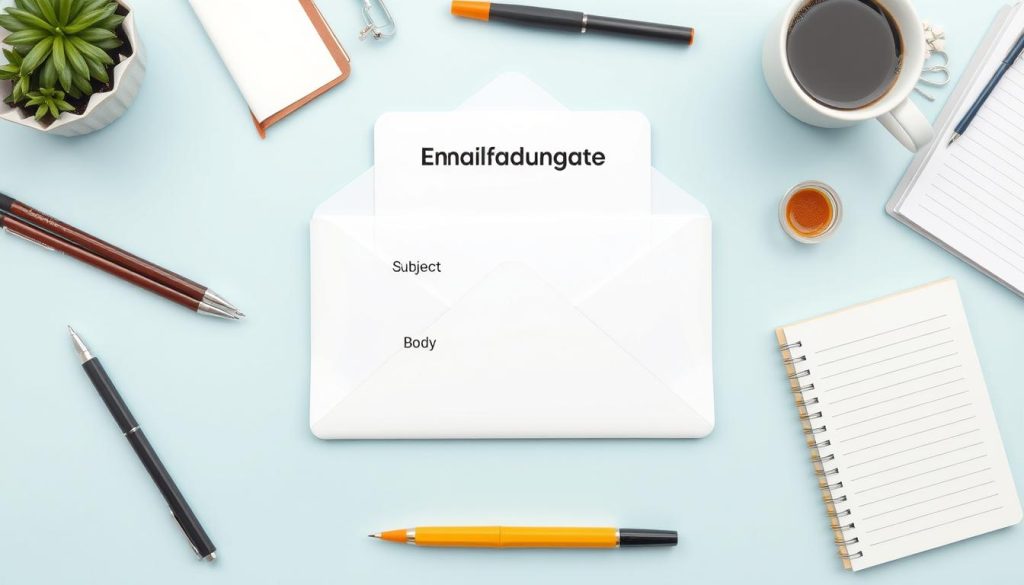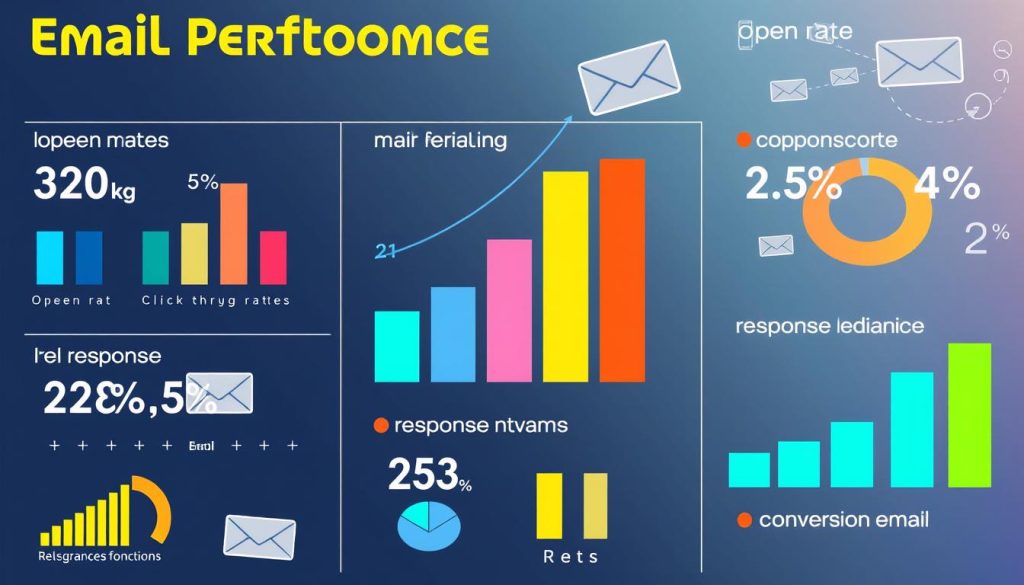Cold emails are key in startup fundraising. They help you reach out to potential investors. This guide will show you how to write emails that catch their eye and open doors to funding.
To succeed in cold emailing, you need to know what investors want. You must tailor your message and follow best practices. We’ll cover how to write great subject lines, structure your email, and avoid mistakes.
Key Takeaways
- Personalize your emails to each investor’s interests and background
- Craft attention-grabbing subject lines that entice opens
- Keep your message concise, focusing on your unique value proposition
- Include a clear call-to-action to guide next steps
- Follow up strategically without being pushy
- Track and analyze your email performance to improve results
Understanding the Fundamentals of Startup Fundraising Cold Emails
Startup fundraising often uses cold emails to find investors. These emails are key to many fundraising plans. Let’s explore how to write great cold emails for your startup’s money needs.
The Psychology Behind Successful Cold Outreach
Good cold outreach connects with people. It sparks interest by meeting the investor’s needs. Your email should show how your startup can help them.
Why Cold Emails Remain Critical in Modern Fundraising
Cold emails are still vital for startups, even with social media. They offer a direct way to talk to investors. This lets you control your message and timing, making them essential.
Key Components of Effective Fundraising Emails
Great fundraising emails have a few things in common:
- A catchy subject line that grabs attention
- Personalization that shows you’ve done your homework
- A clear value proposition explaining why your startup is worth investing in
- A concise yet compelling pitch
- A strong call-to-action guiding the next steps
These parts work together to engage investors and get results. By learning these basics, you’ll write cold emails that open doors for your startup.
Crafting the Perfect Subject Line for Investor Outreach
The subject line is your first chance to impress potential investors. It’s key for nonprofit emails and reaching out to donors. A good subject line can make your email stand out or get lost in the inbox.
- Personalization: Include the investor’s name or company
- Urgency: Create a sense of time-sensitivity
- Value proposition: Highlight the benefit for the investor
- Curiosity: Spark interest without giving everything away
Now, let’s look at some great subject lines for investor outreach:
| Subject Line | Why It Works |
|---|---|
| [Investor Name], Our AI Solution Cuts Costs by 40% | Personalized and highlights a clear value proposition |
| 10 Min Call This Week? Revolutionary EdTech Startup | Creates urgency and sparks curiosity |
| Exclusive Opportunity: Join Our Oversubscribed Round | Implies scarcity and appeals to FOMO |
| We’re Disrupting [Industry] – See Our 300% Growth | Showcases traction and potential market impact |
Your subject line should match your email’s content. It’s the first step into your pitch. Take your time to craft it, and you’ll see more opens and interest from investors.
Startup Fundraising Cold Email Guide: Essential Steps and Strategies
Making great cold emails is key for getting startup funding. This guide will show you how to write project proposal emails and grant application emails that grab investors’ interest.
Identifying Your Target Investors
Finding the right investors is crucial. Look for those who have backed similar industries or shown interest in your field. Make a list of potential investors, noting their past investments and what they like.
Creating Your Value Proposition
Your value proposition should clearly show what makes your startup special and why it’s a good investment. Highlight the problem you solve and how your solution is unique. This is critical for project proposal emails and grant application emails.
Personalizing Your Approach
Customize your emails for each investor. Mention their past investments or recent comments to show you’ve done your homework. This personal touch can greatly boost your response rate.
| Email Component | Key Strategy |
|---|---|
| Subject Line | Concise, intriguing, relevant to investor |
| Opening | Personal connection or mutual interest |
| Value Proposition | Clear, unique, market-focused |
| Call to Action | Specific, low-commitment ask |
By using these strategies, you can craft compelling project proposal emails and grant application emails. These will grab investors’ attention and help you secure funding for your startup.
Building a Compelling Email Structure That Converts
Creating effective crowdfunding and sponsorship emails needs a solid plan. A good email structure can really help you get the funding you need. Let’s look at what makes a fundraising email persuasive.

Opening Hook Techniques
Your email’s start is crucial. Begin with a hook that grabs the investor’s interest. Try a question, a surprising fact, or a short story that ties to your project. For instance, “What if you could change how people travel?” This hook keeps the reader interested.
Body Content Organization
Keep your email body simple and clear. Start with what makes your project special, then share key points. Use short paragraphs and bullet points for easy reading. When talking about crowdfunding, focus on what makes your project stand out and its market potential.
Call-to-Action Best Practices
End with a clear call-to-action (CTA). It should be direct, specific, and simple to do. For sponsorship emails, your CTA might be “Book a 15-minute call” or “Check out our pitch deck.” Make your CTA stand out and create a sense of urgency without being too aggressive.
Success in fundraising emails comes from balancing info with persuasion. Keep your message focused, personal, and relevant to your investor’s interests for the best outcome.
Personalizing Your Pitch for Different Types of Investors
When you’re reaching out to investors, making your pitch personal is key. You need to adjust your approach based on who you’re talking to. This is true for both capital campaign emails and impact project funding emails.
Angel investors love entrepreneurs who are passionate and have new ideas. Talk about your vision and how it solves a big problem. Venture capitalists, however, want to see your growth potential and market success. Show them your progress and how you plan to grow.
Impact investors care about making money and doing good at the same time. When you pitch to them, talk about how your project makes a difference and can also make money.
| Investor Type | Key Focus | Pitch Emphasis |
|---|---|---|
| Angel Investors | Innovation and Passion | Problem-solving vision |
| Venture Capitalists | Growth and Market Potential | Traction and scalability |
| Impact Investors | Social/Environmental Returns | Positive change and profitability |
No matter who you’re pitching to, always make your language and numbers fit their needs. A personalized pitch can really help you succeed in getting the funds you need.
“The key to successful fundraising is understanding your audience and speaking their language.”
Common Mistakes to Avoid in Fundraising Cold Emails
Creating effective fundraising email tactics is key for successful campaigns. To boost your success, avoid common mistakes that can harm your efforts.
Content and Formatting Errors
Poor content quality is a major mistake in fundraising emails. Typos, grammatical errors, and unclear messages can lose potential investors. Keep your emails short, clear, and free of jargon.
Use bullet points to highlight important info. This makes your email easy to read.
Timing and Follow-up Mistakes
Timing is crucial in email marketing. Sending emails at the wrong time or sending too many follow-ups can backfire. Send emails during business hours and space out follow-ups.
A good rule is to wait at least a week before sending a reminder.
Technical Pitfalls to Watch For
Technical issues can hurt your fundraising email success. Make sure your emails work well on mobile devices. Test them on different devices and email clients to ensure they look right.
Also, keep an eye on your sender reputation to avoid spam folders.
- Use a professional email address
- Avoid attachments in initial emails
- Optimize email subject lines for visibility
Avoiding these mistakes can make your fundraising cold emails more effective. This increases your chances of getting investor interest.
Follow-up Strategies That Actually Work
Mastering follow-up techniques is key for successful nonprofit email outreach and donor engagement emails. It’s all about finding the right balance between being persistent and respecting the recipient’s time.
Timing is everything in follow-up emails. Send your first follow-up 3-5 days after the initial contact. This gives the recipient time to think about your message without forgetting it.
How often you follow up is also important. Space out your follow-ups, making the time between each one longer. This keeps you in the recipient’s mind without being too much.
- First follow-up: 3-5 days after initial email
- Second follow-up: 7-10 days later
- Third follow-up: 2-3 weeks later
Content is crucial in donor engagement emails. Each follow-up should bring something new, not just a reminder. Share updates, offer more insights, or include relevant news articles to keep interest high.
“The art of following up lies in adding value with each interaction, not just asking for a response.”
The goal is to build a relationship, not just get an immediate response. By using these strategies, you’ll boost your chances of success in your nonprofit email outreach efforts.
| Follow-up Type | Content Focus | Ideal Timing |
|---|---|---|
| Value-Add | New project insights | 3-5 days after initial |
| News Update | Relevant industry news | 7-10 days after first follow-up |
| Final Outreach | Closing thoughts and open door | 2-3 weeks after second follow-up |
Measuring and Optimizing Your Cold Email Performance
To get the most out of your project proposal and grant application emails, it’s key to measure and improve them. Track important metrics, try A/B testing, and use optimization techniques. This way, you can make your emails better and boost your chances of getting funding.
Key Metrics to Track
When checking how well your fundraising emails do, focus on these key metrics:
- Open rate: The percentage of people who open your email
- Click-through rate: The percentage of people who click on links in your email
- Response rate: The percentage of people who reply to your email
- Conversion rate: The percentage of people who do what you want them to (like schedule a meeting)

A/B Testing Strategies
Use A/B testing to make your emails better. Try different things like subject lines, email content, and call-to-action buttons. Send two versions of your email to a few people and see which one works best.
Optimization Techniques
Here are ways to make your emails better:
- Make your emails personal by knowing what investors like
- Write catchy subject lines that grab attention
- Keep your emails short and focused on what you offer
- Make it clear what you want people to do next
- Send emails when it’s best for the people you’re emailing
| Metric | Good Performance | Excellent Performance |
|---|---|---|
| Open Rate | 20-30% | 30%+ |
| Click-through Rate | 2-5% | 5%+ |
| Response Rate | 5-10% | 10%+ |
| Conversion Rate | 1-3% | 3%+ |
Legal Considerations and Compliance in Email Fundraising
Email fundraising must follow the law. This includes crowdfunding and asking for sponsorships. The CAN-SPAM Act in the U.S. sets rules for sending emails and what recipients can expect.
- Use accurate header information
- Avoid deceptive subject lines
- Identify the message as an advertisement
- Include your physical address
- Provide a clear opt-out method
- Honor opt-out requests promptly
Rules like GDPR also affect email fundraising. You must get consent to contact people and keep their data safe. Be clear about how you use their information in your emails.
| Regulation | Key Requirements |
|---|---|
| CAN-SPAM Act | Accurate headers, opt-out option, physical address |
| GDPR | Consent, data protection, transparency |
| CCPA | Data disclosure, opt-out rights, non-discrimination |
Keep checking your email methods to stay legal. Talk to lawyers to make sure your emails are right for where you are. This helps keep your fundraising fair and legal.
Tools and Resources for Effective Email Campaigns
To boost your capital campaign email initiatives, it’s crucial to use the right tools. Let’s explore some key resources that can help streamline your startup fundraising cold email guide.
Email Management Platforms
Platforms like Mailchimp and SendGrid can supercharge your fundraising efforts. They offer features like automated sends, personalization, and list segmentation. This makes managing large-scale email campaigns easy, letting you focus on crafting your pitch.
Analytics Tools
Google Analytics and Mixpanel provide deep insights into your email performance. They track open rates, click-through rates, and conversion metrics. With this data, you can refine your approach and boost your fundraising success rate.
Template Resources
Websites like Canva and Hubspot offer professionally designed email templates. These can serve as great starting points for your capital campaign email initiatives. Remember to customize these templates to fit your unique startup story and fundraising goals.
FAQ
What’s the ideal length for a startup fundraising cold email?
A good length for a cold email is 200-300 words. This lets you share your main points quickly. It keeps the investor’s interest. Remember, keeping it short is key.
How often should I follow up after sending a cold email to an investor?
Wait 5-7 business days before your first follow-up email. If there’s no reply, send another after a week. Too many follow-ups can seem pushy.
What should I include in my email subject line to increase open rates?
Make your subject line short, interesting, and relevant. Use your startup’s unique selling point or a surprising statistic. For example: “Revolutionary AI Solution Cuts Costs by 50%” or “Seeking 5 Minutes: Game-Changing Green Tech Investment Opportunity”.
How can I personalize my cold emails to investors?
Personalize by researching the investor. Mention their recent investments or articles. Show how your startup fits their interests. This shows you’ve done your homework.
Is it okay to use email templates for fundraising outreach?
Email templates can save time, but customize them for each investor. They should be a starting point, not a one-size-fits-all solution. Tailor the content and tone to each investor’s profile.
What are some common mistakes to avoid in fundraising cold emails?
Avoid being too generic, sending long emails, and not clearly stating your value. Don’t use too much jargon and include a clear call-to-action. Also, check for spelling errors and address the investor correctly.
How can I make my startup stand out in a crowded inbox?
Highlight your unique selling point clearly and briefly. Use data or social proof to support your claims. Include a compelling story about your startup. Make sure your email is easy to scan.
What metrics should I track to measure the success of my fundraising email campaigns?
Track open rates, click-through rates, response rates, and meeting request rates. Also, monitor bounce and unsubscribe rates. Use these metrics to improve your strategy.
Are there any legal considerations I should be aware of when sending fundraising emails?
Yes, follow anti-spam laws like the CAN-SPAM Act. Don’t use misleading subject lines and include your address. Provide an easy unsubscribe option. Be aware of GDPR if reaching out to European investors.
What’s the best way to end a fundraising cold email?
End with a clear call-to-action. Instead of “Let me know if you’re interested,” say “Would you be available for a 15-minute call next Tuesday at 2 PM to discuss this further?” This makes it easy for the investor to respond.


